Exploring the Cognitive Reconstruction Mechanism of Generative AI in Outcome-Based Design Education: A Study on Load Optimization and Performance Impact Based on Dual-Path Teaching
Abstract
1. Introduction
2. Literature Review
2.1. The Application of CL Theory in Design Education
2.2. Cognitive Intervention Mechanisms for Generative AI
2.3. Research on Transformation of Design Thinking
3. Materials and Methods
3.1. Experimental Design
3.1.1. Sample Selection and Site Characteristics
3.1.2. Dual-Path Implementation Process and Variable Control
3.2. Variable Definition and Measurement
3.2.1. Independent Variable—Teaching Intervention (Latent Variable)
3.2.2. Mediating Variables (Latent Variables)
- Critical Reconstruction Behaviors (Group A Only)
- Word segmentation statistics were obtained using NLPAR-Parser 2021 software (Ling-join Software, Beijing, China).
- Professional term counts were calculated through pre-set lexicon matching.
- Cross-domain terms were identified using the Latent Dirichlet Allocation (LDA) topic model for non-landscape theme detection (e.g., “technology”, “art”).
- 2.
- CL Variable (Latent Variable)
3.2.3. Dependent Variable—Design Quality (Observed Variable)
3.3. Data Analysis Method
3.3.1. SEM Construction and Verification
3.3.2. Qualitative Data Analysis and Verification
4. Results
4.1. Descriptive Statistics and Cross-Over Analysis of Dual-Path Variables
4.1.1. Differences in Design Quality and CL Scores Between Teaching Paths
4.1.2. Critical Reconstruction of Behavioral Characteristics in Group A
4.2. Verification of CL’s Mediating Effect
4.2.1. SEM Model Fitting Results
4.2.2. Path Coefficient Analysis and Mechanism Explanation
- Group T exhibited “dual complete mediation”: teaching intervention affected design quality solely through InCL and ExCL, with no significant direct effect.
- ExCL complete mediation (Path 1): ExCL acted as a critical bottleneck (total indirect effect = −0.899), reflecting how inefficient information organization in traditional teaching constrains quality.
- InCL complete mediation (Path 3): InCL mediation (total indirect effect = 0.927) further confirmed that task complexity alone dominates cognitive resource allocation without AI support.
- Group A exhibited a significant direct effect (p < 0.05) with non-zero indirect effects, categorized as partial mediation.
- ExCL and InCL partial mediation (Paths 1 and 3): Total indirect effects of −0.0001 and 0.310 alongside retained direct effects (0.329) form a dual mechanism of “load optimization + direct guidance”.
4.3. Quantitative Analysis of Differences in Dual-Path Mechanisms
5. Discussion
5.1. Interpretation of Core Results and Mechanism Explanation
5.1.1. Structural Differences in Dual-Path Effect
5.1.2. Interaction Mechanism Between CL and Critical Reconstruction Behavior
- Quantitative Evidence and Typical Cases of Behavioral Heterogeneity
- 2.
- Theoretical explanation and contradiction analysis of behavior-load interaction
5.2. Theoretical Contribution
5.3. Teaching Practice Strategies
- Traditional teaching enhancement: three-tier AI prompt imitation writing training
- Describe site issues (e.g., “inefficient street green space”, “bulky walking aids for the elderly”);
- Transform into strategic keywords (“ aging-friendly + Rain Garden”, “lightweight materials + folding structures”, etc.);
- Form generative descriptions (“Sunken Seat + Ecological Grass Planting Ditch”, “streamlined shells”, etc.).
- 2.
- AI teaching can develop an “iterative threshold prompt system”
- 3.
- Evaluation system innovation: three-dimensional “behavior–load–quality” framework
- Behavioral indicators (prompt iteration count, cross-domain term frequency) into design quality criteria;
- Dynamic CL scale monitoring of ExCL and GeCL balance.
5.4. Research Limitations and Future Directions
- Large-sample validation to refine theoretical mechanisms: Expand critical reconstruction behavior typology with n ≥ 50 per group to better quantify how behavioral types moderate CL mediation; adopt between-group control (independent Group T and Group A) or cross-over designs to eliminate sequence effects, thereby strengthening causal inferences about AI’s impact on CL redistribution (half of students complete Group T then Group A, and vice versa). Employ cross-lag modeling to track temporal causality and mitigate sequence effects [40].
- Multimodal tools to deepen CL theory integration: Develop BERT-based algorithms to assess prompt logical chain integrity in real time, linking semantic similarity to GeCL and ExCL dynamics; integrate eye-tracking to quantify visual attention allocation, enhancing understanding of how AI interaction reshapes cognitive resource allocation patterns in CL theory.
- Intervention tool refinement for educational practice: Develop intelligent prompt assistance systems with real-time feedback on critical reconstruction behaviors (e.g., iteration frequency alerts, cross-domain term suggestions), tailored to reduce ExCL and enhance GeCL in line with CL theory principles.
6. Conclusions
Author Contributions
Funding
Institutional Review Board Statement
Informed Consent Statement
Data Availability Statement
Conflicts of Interest
Abbreviations
| CL | Cognitive Load |
| AI | Artificial Intelligence |
| InCL | Intrinsic Load |
| ExCL | Extraneous Load |
| GeCL | Germane Load |
| SEM | Structural Equation Model |
Appendix A
| Mentoring Support | Time Investment (Class Hours) | Case Resources (Number of Adopted Cases) |
|---|---|---|
| □ | □ | □ |
| Dimension | Example of the Item | ||
|---|---|---|---|
| Group T | Group A | ||
| Internal cognitive load | Task complexity | It is tough for me to understand the core requirements of this design task | |
| Concept Understanding Difficulty | It is tough to understand the site and carry out the design | It is tough to understand the logic of the AI generation scheme | |
| Difficulty of creative generation | The novel design plan makes me feel exhausted | ||
| Extrinsic cognitive load | Tool operation burden | The technique of hand-drawing consumes a lot of my energy | It is tough to operate the AI platform |
| Information presentation problem | The clarity of design information | The clarity of the AI feedback information | |
| Time pressure | Completing the scheme design within the prescribed time makes me anxious | ||
| Associated cognitive load | Sense of knowledge integration | I can apply the classroom theories to the actual design | Understand the principles of AI generation schemes |
| Sense of engagement in learning | When optimizing the plan, multiple possibilities were actively tried | ||
| Migration application confidence | The design experience gained this time will be of great help for future projects. | AI-assisted methods are of great help to future projects | |
References
- Eisner, E.W. Current Issues in Art and Design Education: Art Education Today: A Look at its Past and an Agenda for the Future. Int. J. Art Des. Educ. 2010, 8, 153–166. [Google Scholar] [CrossRef]
- Sazonova, M.V.; Mikhailova, L.V. Transformation of personalized educational trajectories of students of higher educational institutions in the context of the development of digital technologies. AIP Conf. Proc. 2024, 2969, 7. [Google Scholar] [CrossRef]
- Jing, Y. Present Situation and Trend of Diversified Development of Art Design Education System in China. In Proceedings of the International Conference on Arts, Moscow, Russia, 22–24 April 2015. [Google Scholar] [CrossRef][Green Version]
- López-Galisteo, A.J.; Borrás-Gené, O. The Creation and Evaluation of an AI Assistant (GPT) for Educational Experience Design. Information 2025, 16, 117. [Google Scholar] [CrossRef]
- Meron, Y.; Araci, Y.T. Artificial intelligence in design education: Evaluating ChatGPT as a virtual colleague for post-graduate course development. Des. Sci. 2023, 9, e30. [Google Scholar] [CrossRef]
- Abdallah, Y.K.; Estévez, A.T. Biomaterials Research-Driven Design Visualized by AI Text-Prompt-Generated Images. Designs 2023, 7, 48. [Google Scholar] [CrossRef]
- Chen, Y.; Qin, Z.; Sun, L.; Wu, J.; Ai, W.; Chao, J.; Li, H.; Li, J. GDT Framework: Integrating Generative Design and Design Thinking for Sustainable Development in the AI Era. Sustainability 2025, 17, 372. [Google Scholar] [CrossRef]
- Chandler, P.; Sweller, J. Cognitive Load Theory and the Format of Instruction. Cogn. Instr. 1991, 8, 293–332. [Google Scholar] [CrossRef]
- Kalyuga, S. Cognitive Load Theory: How Many Types of Load Does It Really Need? Educ. Psychol. Rev. 2011, 23, 1–19. [Google Scholar] [CrossRef]
- Paas, F.; Renkl, A.; Sweller, J. Cognitive Load Theory and Instructional Design: Recent Developments. Educ. Psychol. 2003, 38, 1–4. [Google Scholar] [CrossRef]
- Merriënboer, J.; Sweller, J. Cognitive load theory in health professional education: Design principles and strategies. Med. Educ. 2010, 44, 85–93. [Google Scholar] [CrossRef]
- Gkintoni, E.; Antonopoulou, H.; Sortwell, A.; Halkiopoulos, C. Challenging Cognitive Load Theory: The Role of Educational Neuroscience and Artificial Intelligence in Redefining Learning Efficacy. Brain Sci. 2025, 15, 203. [Google Scholar] [CrossRef]
- Yang, Y.; Leung, H.; Yue, L.; Deng, L. Generating a two-phase lesson for guiding beginners to learn basic dance movements. Comput. Educ. 2013, 61, 1–20. [Google Scholar] [CrossRef]
- Yavuz, S. Can Generative AI and ChatGPT Break Human Supremacy in Mathematics and Reshape Competence in Cognitive-Demanding Problem-Solving Tasks? J. Intell. 2025, 13, 43. [Google Scholar] [CrossRef]
- Vygotsky, L.S. Mind in society: The development of higher psychological processes. In Mind in Society: The Development of Higher Psychological Processes; Harvard University Press: Cambridge, MA, USA; London, UK, 1978; Volume 1+3, pp. 19–30+40–51. [Google Scholar]
- Guilford, J.P. The Nature of Human Intelligence; McGraw-Hill: Columbus, OH, USA, 1967. [Google Scholar]
- Kamnerddee, C.; Putjorn, P.; Intarasirisawat, J. AI-Driven Design Thinking: A Comparative Study of Human-Created and AI-Generated UI Prototypes for Mobile Applications. In Proceedings of the 2024 8th International Conference on Information Technology (InCIT), Chonburi, Thailand, 14–15 November 2024. [Google Scholar] [CrossRef]
- Li, F.; Yan, X.; Su, H.; Shen, R.; Mao, G. An Assessment of Human–AI Interaction Capability in the Generative AI Era: The Influence of Critical Thinking. J. Intell. 2025, 13, 62. [Google Scholar] [CrossRef] [PubMed]
- Goldschmidt, G. The dialectics of sketching. Creat. Res. J. 1991, 4, 123–143. [Google Scholar] [CrossRef]
- Tang, C.; Lou, Y. Exploration of the Application of Experiential Teaching in the Enlightenment Phase of Architectural Education. Design 2025, 38, 75–79. [Google Scholar] [CrossRef]
- Wong, M.; Rios, T.; Menzel, S.; Ong, Y.S. Prompt Evolutionary Design Optimization with Generative Shape and Vision-Language models. In Proceedings of the 2024 IEEE Congress on Evolutionary Computation (CEC), Yokohama, Japan, 30 June 2024. [Google Scholar] [CrossRef]
- Tan, L.; Luhrs, M. Using Generative AI Midjourney to enhance divergent and convergent thinking in an architect’s creative design process. Des. J. 2024, 27, 677–699. [Google Scholar] [CrossRef]
- Liu, B.; Wang, W.; Liu, X.; Wu, J. Research on Innovative Design of Interactive Learning Environment for Architectural Education Integrating Artificial Intelligence and Virtual Reality Technology. Appl. Math. Nonlinear Sci. 2024, 9, 1. [Google Scholar] [CrossRef]
- Hubert, K.F.; Awa, K.N.; Zabelina, D.L. The current state of artificial intelligence generative language models is more creative than humans on divergent thinking tasks. Sci. Rep. 2024, 14, 3440. [Google Scholar] [CrossRef]
- Merriam, S.B. Qualitative Research and Case Study Applications in Education. Br. Educ. Res. J. 1998, 41, 287–302. [Google Scholar] [CrossRef]
- Chen, Y.; Zhang, L.; Yin, H. A Longitudinal Study on Students’ Foreign Language Anxiety and Cognitive Load in Gamified Classes of Higher Education. Sustainability 2022, 14, 10905. [Google Scholar] [CrossRef]
- He, S.; Wu, J.; Qin, J. How Do Designers Collaborate with AI: Teaching Practice and Reflection on AIGC Empowered Design Workshop. Art Des. Res. 2025, 1, 123–129. [Google Scholar]
- Elsomcook, M.T. Environment Design and Teaching Intervention; Springer: Berlin/Heidelberg, Germany, 1993. [Google Scholar] [CrossRef]
- Lu, D.; Xie, Y. The Intervention Model and Strategies of Blended Learning Environment with Orientation of Critical Thinking: A Design-Based Research. J. Northeast. Norm. Univ. (Philos. Soc. Sci.) 2020, 3, 143–151. [Google Scholar] [CrossRef]
- Landa-Blanco, M.; Cortés-Ramos, A. Psychology students’ attitudes towards research: The role of critical thinking, epistemic orientation, and satisfaction with research courses. Heliyon 2021, 7, e08504. [Google Scholar] [CrossRef]
- Hart, S.G. Nasa-task load index (Nasa-TLX); 20 years later. Proc. Hum. Factors Ergon. Soc. Annu. Meet. 2006, 50, 904–908. [Google Scholar] [CrossRef]
- Lox, C.L.; Jackson, S.; Tuholski, S.W.; Wasley, D.; Treasure, D.C. Revisiting the Measurement of Exercise-Induced Feeling States: The Physical Activity Affect Scale (PAAS). Meas. Phys. Educ. Exerc. Sci. 2000, 4, 79–95. [Google Scholar] [CrossRef]
- Xiao, G.; Zhang, J. On Comprehensive Assessment System of Landscape Architecture Planning. J. Southwest Agric. Univ. (Soc. Sci. Ed.) 2006, 01, 150–155. [Google Scholar]
- Duan, X.; Lin, B.; Meng, L.; Zhao, F. A Method for Selecting and Optimizing Pocket Park Design Proposals Based on Multi-Attribute Decision Making. Buildings 2025, 15, 1026. [Google Scholar] [CrossRef]
- Hu, L.T.; Bentler, P.M. Cutoff criteria for fit indexes in covariance structure analysis: Conventional criteria versus new alternatives. Struct. Equ. Model. 1999, 6, 1–55. [Google Scholar] [CrossRef]
- Byrne, B.M. Testing for Multigroup Invariance Using AMOS Graphics: A Road Less Traveled. Struct. Equ. Model. A Multidiscip. J. 2004, 11, 272–300. [Google Scholar] [CrossRef]
- Bie, F.; Yang, Y.; Zhou, Z.; Ghanem, A.; Zhang, M.; Yao, Z.; Wu, X.; Holmes, C.; Golnari, P.; Clifton, D.A. RenAIssance: A Survey Into AI Text-to-Image Generation in the Era of Large Mode. Pattern Analysis and Machine Intelligence. IEEE Trans. Pattern Anal. Mach. Intell. 2024, 47, 2212–2231. [Google Scholar] [CrossRef] [PubMed]
- Leahy, W.; Sweller, J. The imagination effect increases with an increased intrinsic cognitive load. Appl. Cogn. Psychol. 2010, 22, 273–283. [Google Scholar] [CrossRef]
- Bola, M.; Borchardt, V. Cognitive Processing Involves Dynamic Reorganization of the Whole-Brain Network’s Functional Community Structure. J. Neurosci. 2016, 36, 3633. [Google Scholar] [CrossRef]
- Yuan, S.; Cao, W.; Zhang, M.; Wu, S.; Wei, X. The Road to A More Accurate Causal Analysis: New Advances in Cross-lagged Panel Models. Hum. Resour. Dev. China 2021, 38, 23–41. [Google Scholar] [CrossRef]
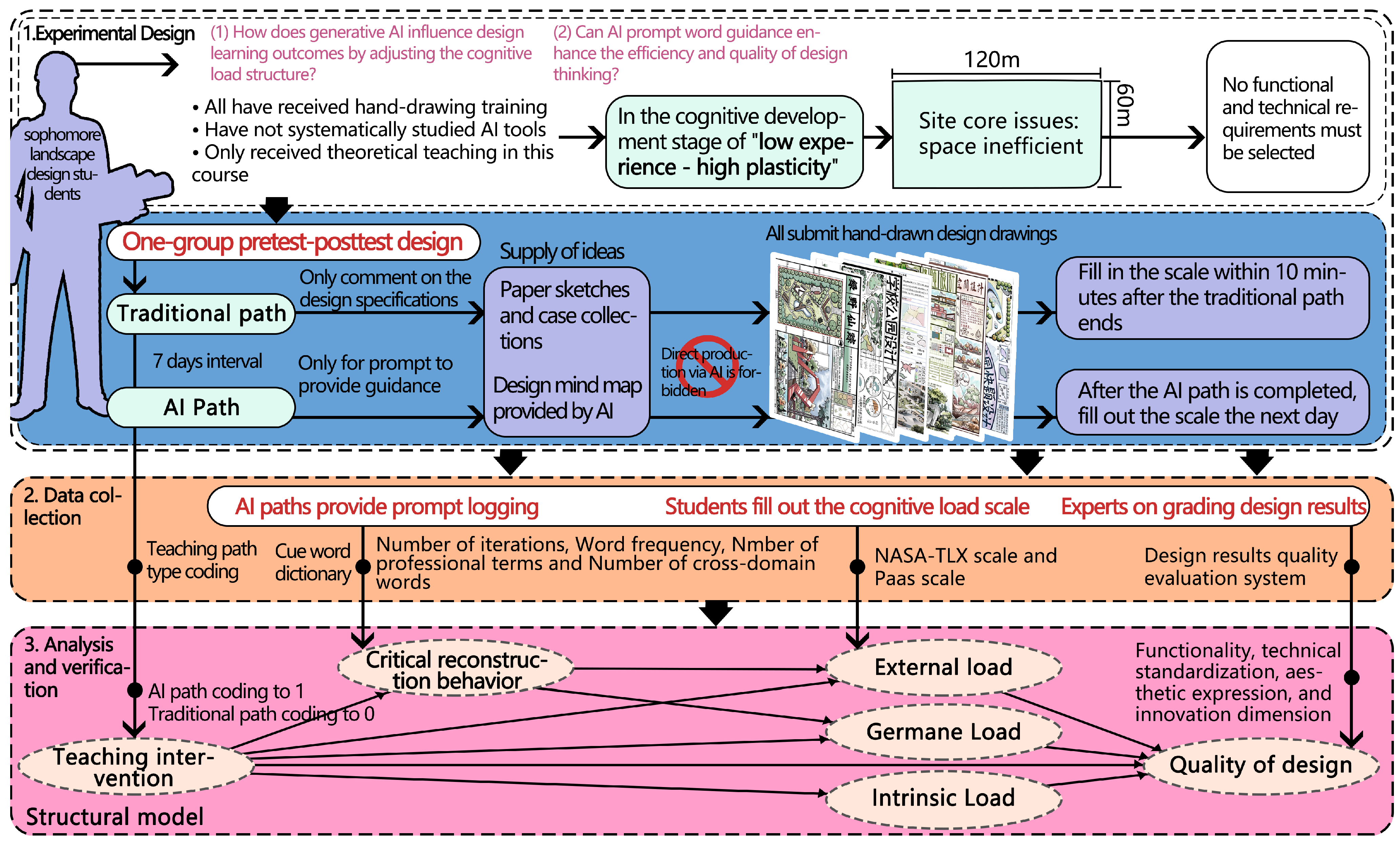
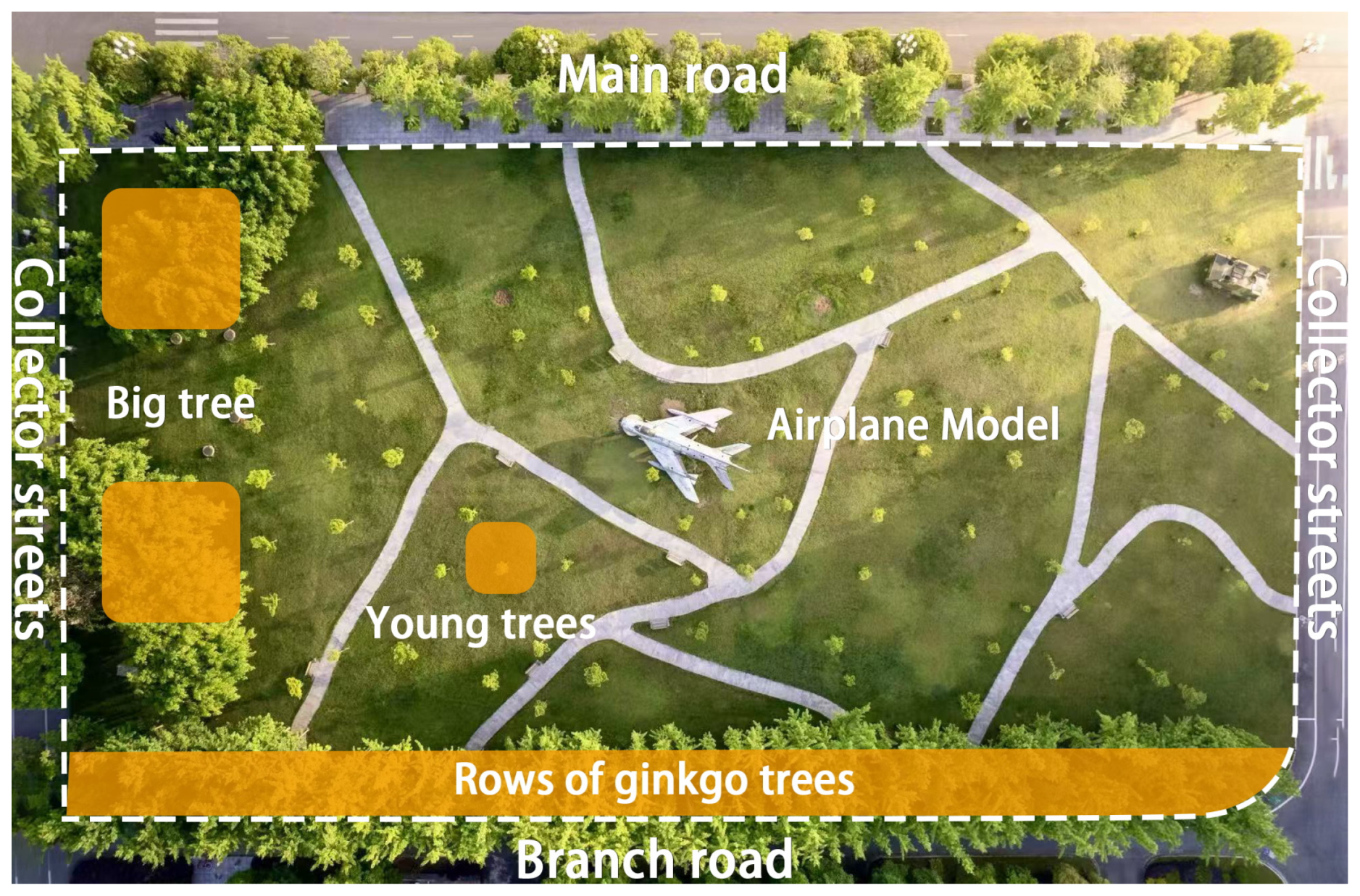
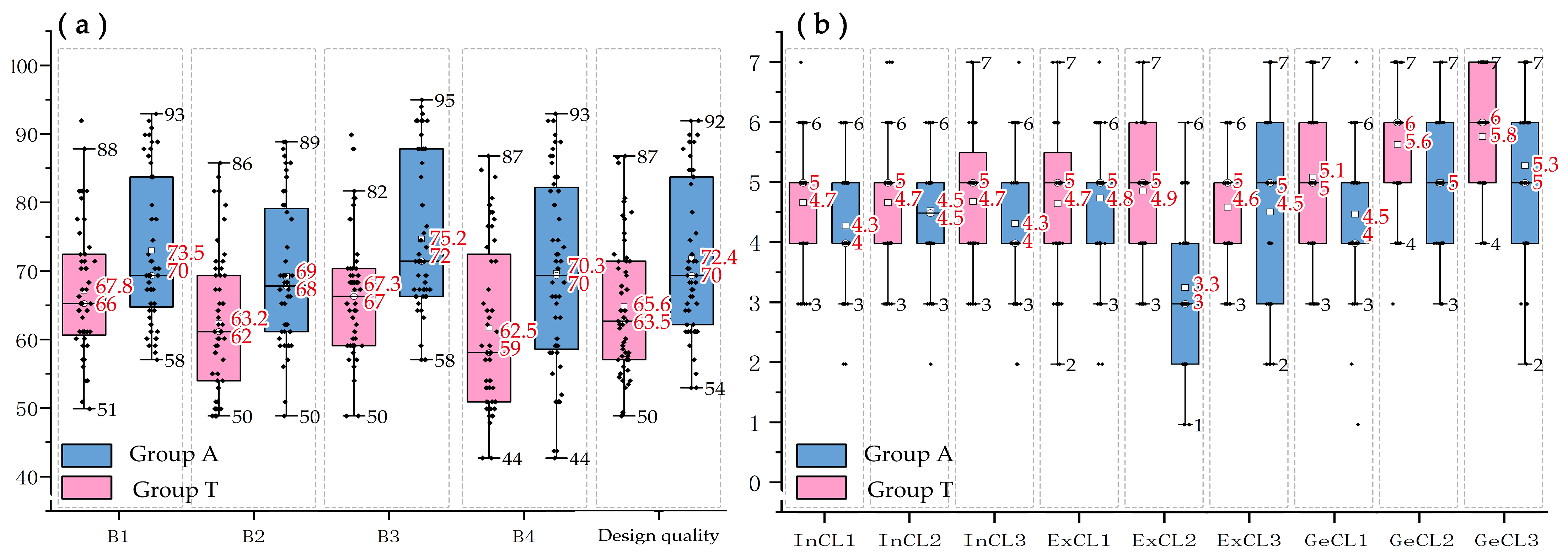
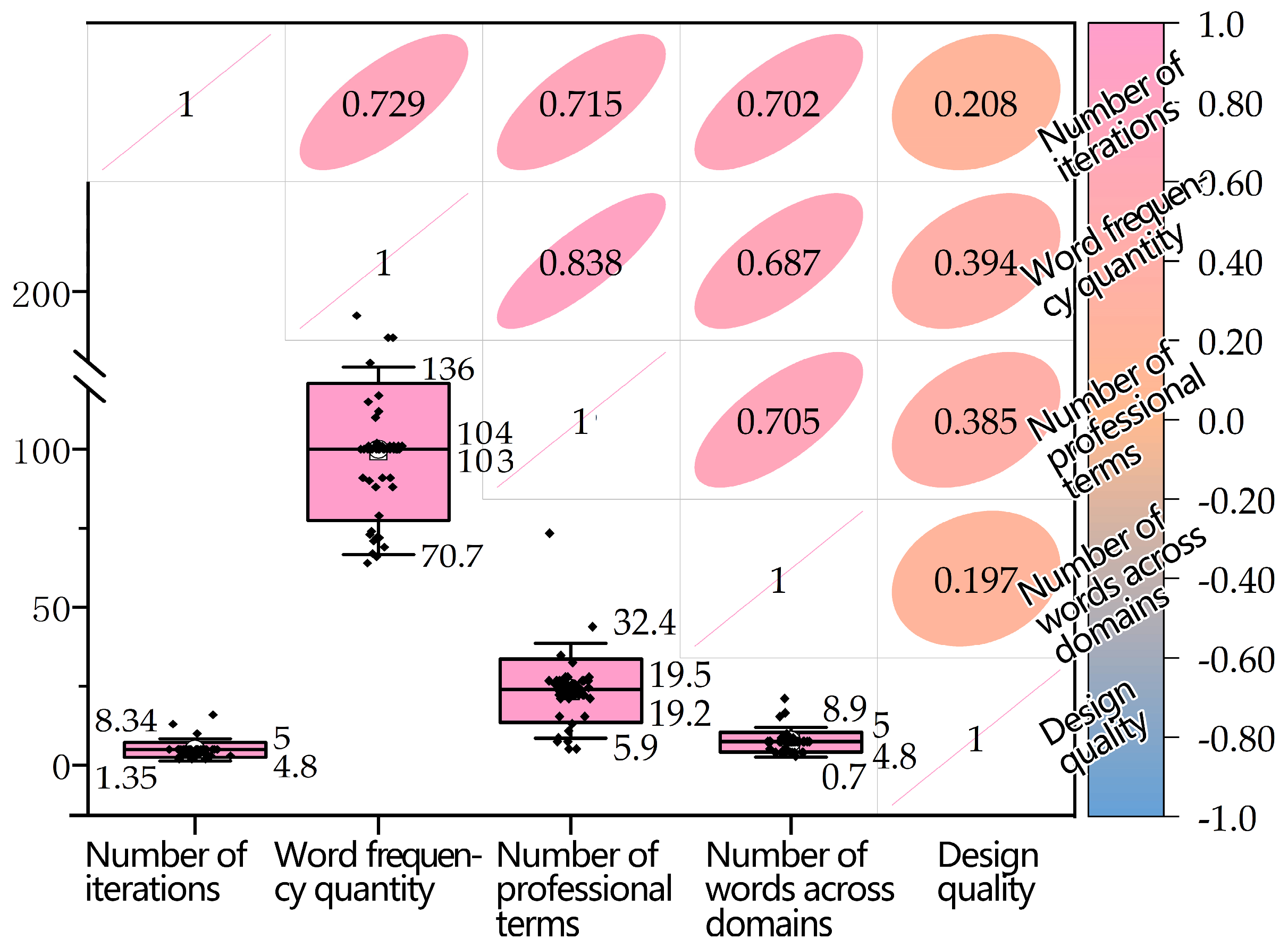
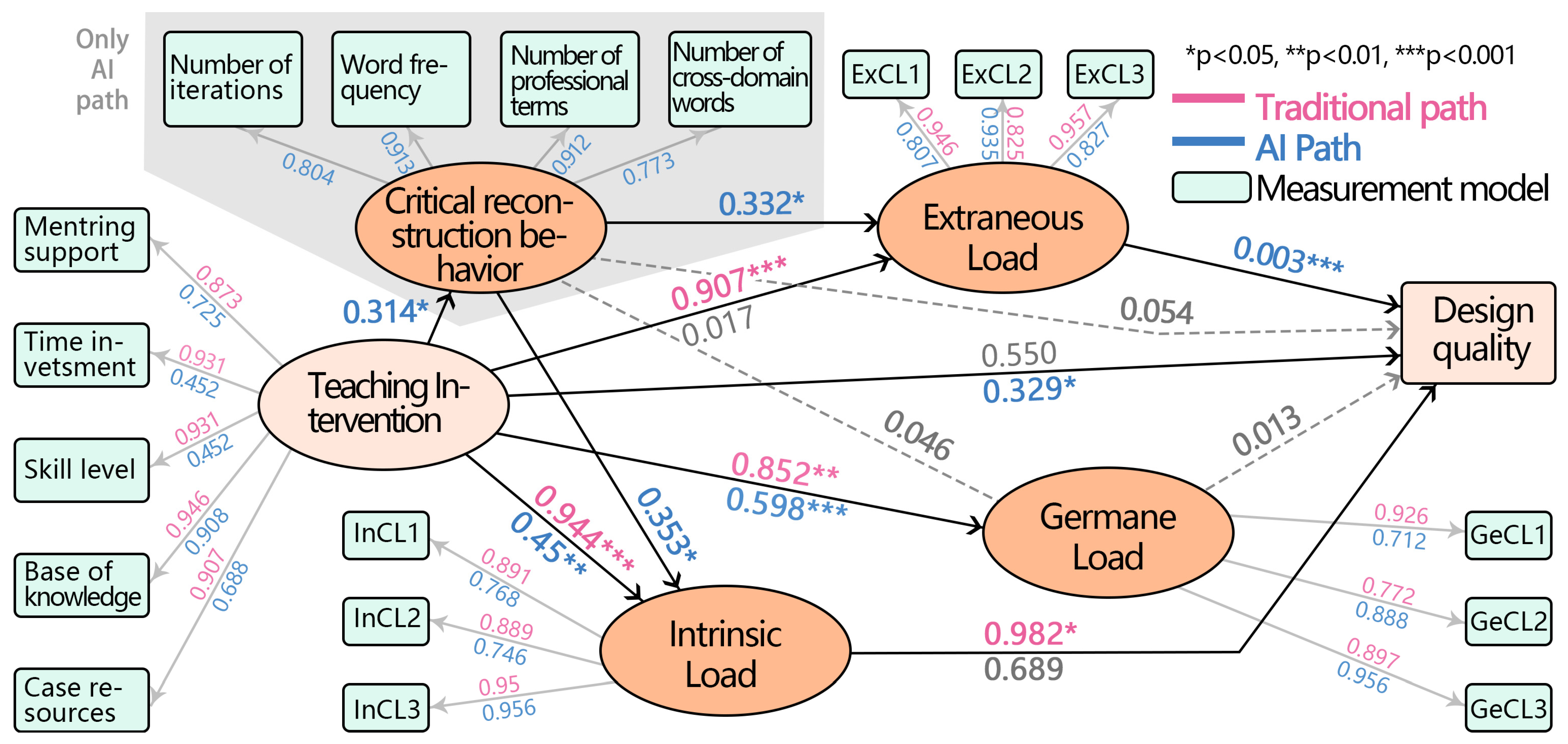
| Stage | Traditional Group (Group T) | AI-Assisted Group (Group A) | Key Points of Control |
|---|---|---|---|
| Tool Limitations | Use case collections | DeepSeek generates design mind maps only | Standardize the technological intervention degree |
| Prompt text construction | - | Three-stage method:
| Prompts must include professional terms (e.g., viewing platforms, flower beds) and recommend cross-domain integration (e.g., aging, narratology). |
| Concept generation | Linear association produces 2–3 directions in 8 class hours; one-way teacher comments (e.g., “Pedestrian road width should be 2 m”) | AI generates three logical chains; screen one direction for deepening; the teacher provides prompt optimization guidance (e.g., “Add ‘flea market’ to strengthen functionality”) | Prohibit AI intervention in Group T; AI path enforces idea guidance |
| Scheme deepening | Manual optimization emphasizes proportion and hand-drawn expression | Complete drawing expression combined with AI-generated concepts | Group A prohibits the direct use of generated graphics |
| Outcome form | A3 hand-drawn floor plan + renderings | A3 hand-drawn floor plan + renderings + prompt text log | Design must mark AI contributions |
| Data Collection | Student CL scale, expert scoring; Group A’s prompt logs | CL measurements were administered at regular time intervals to minimize memory interference, and expert evaluations were conducted under anonymous conditions | |
| Variable Name | Teaching Path | Specific Definition | Quantification Method |
|---|---|---|---|
| Mentoring support | Group T | Number of times teachers provided guidance on traditional design methods (e.g., hand-drawing, sketching) | Count of guidance sessions |
| Group A | Number of times teachers provided guidance on the prompt text for AI tools | ||
| Time investment | Group T | Total class hours spent on Group T design (from concept to initial scheme) | Recorded in units of class hours, accurate to 1 decimal place |
| Group A | Total class hours spent on Group A design (from prompt text writing to initial scheme) | ||
| Skill level | Group T | Proficiency in using hand tools (e.g., pencils, markers) for design tasks | 7-point scale (1 = completely unfamiliar, 7 = very proficient) |
| Group A | Proficiency in AI tool (Midjourney, Stable Diffusion) operation and parameter setting | ||
| Base of knowledge | General | Depth of mastery in landscape design theories, norms | |
| Case resources | Group T | Number of traditional landscape design cases (hand-drawn plans, physical projects) consulted | Count based on the actual number of cases consulted |
| Group A | Number of reference cases generated or retrieved via AI tools during design |
| Observed Variable | Operation Definition | Measuring Tools and Methods | Data Source | |
|---|---|---|---|---|
| Number of iterations | Number of prompt revisions per task | Prompt modification history log (Group A) | ||
| Word frequency | Total word count in prompts (excluding pronouns, adverbs, etc.) | Text word segmentation analysis | Prompt text corpus | Rely on the entire prompt text statistics |
| Number of professional terms | Number of landscape design-specific terms | Design professional vocabulary matching (e.g., “terrain undulation”, “habitat creation”) | Manual coding combined with Python(Python Software Foundation, version 3.11.4, Wilmington, NC, USA) regular expressions | |
| Number of cross-domain words | Number of non-landscape terms | LDA topic modeling for identifying non-landscape topics (e.g., “technology”, “art”) | Prompt text semantic analysis report | |
| Latent Variable | Definition | Dimension | Measuring Tools | Example Items (1–9 Points) | Cronbach’s α |
|---|---|---|---|---|---|
| InCL | Load determined by the task’s inherent complexity | Task complexity (InCL1), Concept Understanding Difficulty (InCL2), Difficulty of creative generation (InCL3) | Adapted from NASA-TLX and Paas scales [31,32] | “Understanding the core requirements of this design task was tough for me.” | 0.742 |
| ExCL | Load resulting from inefficient information presentation or chaotic task organization | Tool operation burden (ExCL1), Information presentation problem (ExCL2), Time pressure (ExCL3) | “When optimizing the plan, multiple possibilities were actively tried.” “AI-assisted methods are of great help to future projects.” | 0.706 | |
| GeCL | Load invested in deep knowledge processing and creative integration | Sense of knowledge integration (GeCL1), Sense of engagement in learning (GeCL2), Migration application confidence (GeCL3) | “The hand-drawn expression techniques have consumed a lot of my energy.” “It is tough to operate the AI platform.” “The clarity of AI feedback information.” | 0.787 |
| Target Layer | Layer of Criterion (Number) | Indicator (Number) | Weights | Scoring Instructions |
|---|---|---|---|---|
| Design Quality Evaluation | Functionality (B1) | Functional rationality (C1) | 0.1959 | The clarity of the main functional zoning, the organization of human flow, and other aspects. |
| Site adaptability (C2) | 0.1438 | The rationality of terrain elevation treatment and the extent of existing vegetation retention and utilization, etc. | ||
| Technical specification (B2) | Drawing standard (C3) | 0.1025 | The accuracy of scale and dimensioning, as well as the standardized use of legend symbols, etc. | |
| Engineering feasibility (C4) | 0.1367 | The turning radius of the road complies with the standards, the spacing of the plantings is reasonable, etc. | ||
| Aesthetic expression (B3) | Aesthetics of Plane Composition (C5) | 0.0716 | The coordination of the relationship between the figure and the base, the sense of rhythm in the virtual and real spaces, etc. | |
| Visual effect (C6) | 0.1570 | The drawing features a clear hierarchy and a harmonious, unified color system. | ||
| Innovativeness (B4) | Conceptual originality (C7) | 0.0353 | The uniqueness of the design theme, the degree of innovation of the spatial prototype, etc. | |
| Formal language innovation (C8) | 0.0623 | The novelty of geometric form composition and the originality of landscape feature design, among others. | ||
| Drawing depth (C9) | 0.0949 | The completeness of key node enlarged drawings, the matching degree between design descriptions and drawings, etc. |
| Grouping Path | Independent Variable(X) | Influence Path | Mediating Variable M1 | Mediating Variable M2 | Dependent Variable: Design Quality (Y) | ||||||
|---|---|---|---|---|---|---|---|---|---|---|---|
| Path Coefficient β (X → M1) | Path Coefficient β (M1 → Y/M2) | Path Coefficient β (M2 → Y) | Total Indirect Effect (β (X → M1) * β (M1 → M2) * β (M2 → Y)) | Direct Effect | Effect Type | Total Effect | |||||
| Group T | Teaching intervention | Path 1 | ExCL | - | 0.907 *** | −0.991 ** | - | −0.899 | 0.55 | Complete mediation | 0.596 |
| Path 2 | GeCL | 0.852 *** | 0.021 | 0.018 | Not significant | ||||||
| Path 3 | InCL | 0.944 *** | 0.982 * | 0.927 | Complete mediation | ||||||
| Group A | Path 1 | ExCL | - | 0.017 * | −0.003 *** | - | −0.0001 | 0.329 * | Partial mediation | 0.684 | |
| Path 2 | GeCL | 0.598 *** | 0.013 | 0.008 | Not significant | ||||||
| Path 3 | InCL | 0.45 ** | 0.689 * | 0.31 | Partial mediation | ||||||
| Path 4 | Critical reconstruction behavior | 0.314 * | 0.054 | 0.017 | Not significant | ||||||
| Path 5 | ExCL | 0.332 * | −0.003 *** | −0.0001 | Partial mediation | ||||||
| Path 6 | GeCL | 0.046 | 0.013 | 0.0014 | Not significant | ||||||
| Path 7 | InCL | 0.353 * | 0.689 * | 0.01 | Partial mediation | ||||||
| Critical Reconstruction Behavioral Types | Quantity (Proportion) | Screening Criteria (All Must Be Met Simultaneously) | ExCL Mean | GeCL Mean | Mean Value of Design Quality | Typical Case Characteristics |
|---|---|---|---|---|---|---|
| Exploratory type | 3 (5.77%) |
| 4.44 ± 0.38 | 5.11 ± 0.69 | 82.33 ± 14.22 | Introduced “digital art” to generate interactive light installations |
| Efficient type | 11 (21.15%) |
| 4.12 ± 0.43 | 4.73 ± 0.99 | 68.18 ± 8.75 | Focused on professional terms to complete terrain design efficiently |
| Conservative type | 5 (9.62%) |
| 4.0 ± 0.62 | 4.67 ± 0.91 | 66.4 ± 3.65 | Relied on traditional terms (e.g., conventional flower bed design) |
Disclaimer/Publisher’s Note: The statements, opinions and data contained in all publications are solely those of the individual author(s) and contributor(s) and not of MDPI and/or the editor(s). MDPI and/or the editor(s) disclaim responsibility for any injury to people or property resulting from any ideas, methods, instructions or products referred to in the content. |
© 2025 by the authors. Licensee MDPI, Basel, Switzerland. This article is an open access article distributed under the terms and conditions of the Creative Commons Attribution (CC BY) license (https://creativecommons.org/licenses/by/4.0/).
Share and Cite
Dong, Q.; He, J.; Li, N.; Wang, B.; Lu, H.; Yang, Y. Exploring the Cognitive Reconstruction Mechanism of Generative AI in Outcome-Based Design Education: A Study on Load Optimization and Performance Impact Based on Dual-Path Teaching. Buildings 2025, 15, 2864. https://doi.org/10.3390/buildings15162864
Dong Q, He J, Li N, Wang B, Lu H, Yang Y. Exploring the Cognitive Reconstruction Mechanism of Generative AI in Outcome-Based Design Education: A Study on Load Optimization and Performance Impact Based on Dual-Path Teaching. Buildings. 2025; 15(16):2864. https://doi.org/10.3390/buildings15162864
Chicago/Turabian StyleDong, Qidi, Jiaxi He, Nanxin Li, Binzhu Wang, Heng Lu, and Yingyin Yang. 2025. "Exploring the Cognitive Reconstruction Mechanism of Generative AI in Outcome-Based Design Education: A Study on Load Optimization and Performance Impact Based on Dual-Path Teaching" Buildings 15, no. 16: 2864. https://doi.org/10.3390/buildings15162864
APA StyleDong, Q., He, J., Li, N., Wang, B., Lu, H., & Yang, Y. (2025). Exploring the Cognitive Reconstruction Mechanism of Generative AI in Outcome-Based Design Education: A Study on Load Optimization and Performance Impact Based on Dual-Path Teaching. Buildings, 15(16), 2864. https://doi.org/10.3390/buildings15162864








